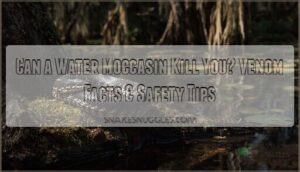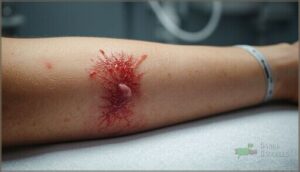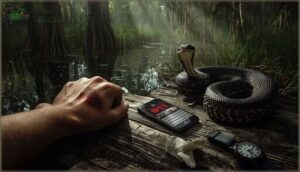This site is supported by our readers. We may earn a commission, at no cost to you, if you purchase through links.

The short answer? Yes, a water moccasin can kill you—but it’s exceedingly rare. Despite their fearsome reputation and genuinely toxic venom, these snakes account for fewer documented fatalities than you’d expect. Most people who get bitten and receive prompt medical care walk away with nothing worse than a painful wound and a good story.
The real danger isn’t the snake itself but what happens when someone ignores the symptoms or can’t reach a hospital quickly enough. Understanding what makes these bites serious, how to recognize the warning signs, and what steps actually save lives can mean the difference between a medical emergency and a tragedy.
Table Of Contents
- Key Takeaways
- Can a Water Moccasin Kill You?
- What is a Water Moccasin?
- Where Are Water Moccasins Found?
- How Dangerous is a Water Moccasin Bite?
- What Are The Symptoms of a Water Moccasin Bite?
- How Fast Do Symptoms Develop?
- What Increases The Severity of a Bite?
- How is a Water Moccasin Bite Treated?
- How Can You Prevent Water Moccasin Bites?
- What Should You Do if Bitten?
- Frequently Asked Questions (FAQs)
- Are water moccasins dangerous?
- Is ricin lethal?
- How to remove a water moccasin?
- Can a water moccasin bite cause death?
- Do water moccasins have venom?
- Can water moccasins bite you underwater?
- Can you survive a water moccasin bite?
- How lethal are water moccasins?
- Will a water moccasin kill a dog?
- Can you kill a water moccasin in Florida?
- Conclusion
Key Takeaways
- Water moccasin bites can kill you, but fatalities are exceptionally rare with modern medical care—most deaths occur when people delay treatment or can’t reach hospitals quickly enough.
- The hemotoxic venom causes serious tissue damage and clotting problems, yet survival rates exceed 99% when antivenom is administered within the first few hours after a bite.
- Most bites happen when people accidentally step on or corner these snakes in southeastern wetlands, making awareness and protective footwear your best defense against strikes.
- Immediate symptoms include intense pain and rapid swelling at the bite site, but severe signs like difficulty breathing, uncontrolled bleeding, or shock demand instant emergency care to prevent complications.
Can a Water Moccasin Kill You?
Yes, a water moccasin bite can kill you, but fatalities are rare. Most deaths happen when people ignore the symptoms or can’t reach medical care in time.
Let’s look at the real risk, what the numbers tell us, and why quick treatment makes all the difference.
Fatality Risk of Water Moccasin Bites
Water moccasin bites carry real danger, but fatalities are rare with modern care. The hemotoxic venom can cause serious harm, yet survival factors improve dramatically when you get antivenom quickly.
Here’s what shapes mortality rates for venomous snake bites:
- Venom potency and bite severity vary with each encounter
- Treatment outcomes depend heavily on how fast you reach medical help
- Your overall health influences how your body copes with the venom
Documented Cases and Statistics
Actual death reports from water moccasin bites are surprisingly scarce in recent decades. Medical records show these venomous snake bites rarely turn fatal when you get prompt medical attention and antivenom drugs. Here’s what survival statistics reveal:
| Decade | Fatal Bite Rates | Medical Response Impact |
|---|---|---|
| 1990s | Rare documented cases | Antivenom availability critical |
| 2000s | Exceptionally uncommon | Emergency protocols improved |
| 2010s | Near-zero fatalities | Venom potency understood better |
| 2020s | No detailed registry | Treatment outcomes excellent |
| Overall | Less than 1% mortality | Envenomation trends favor survival |
The Southeast’s medical infrastructure makes a huge difference in outcomes. Understanding clear science information is essential for interpreting these statistics accurately.
Importance of Timely Treatment
Getting to a hospital fast changes everything after a water moccasin bite. Emergency response within hours prevents irreversible tissue damage and shortens your hospital stay markedly. Antivenom administration works best early—delays beyond a few hours let venom effects spiral into complications requiring surgery.
After a water moccasin bite, emergency response within hours prevents irreversible tissue damage and keeps venom complications from requiring surgery
Prompt medical attention gives you the best treatment outcomes, which is why doctors stress immediate transport to emergency medical facilities for all venomous snake bites. Understanding research methodology is essential for developing effective emergency response plans.
What is a Water Moccasin?
Before you can protect yourself, you need to know what you’re dealing with. Water moccasins are often misunderstood, so let’s clear up exactly what they are and what makes them unique.
Here’s what sets these snakes apart.
Scientific Name and Classification
You might know this snake by cottonmouth or water moccasin, but taxonomy studies pin it down as Agkistrodon piscivorus. That biological nomenclature places it firmly within the pit viper family, and species identification hinges on getting the genus classification right.
- The genus Agkistrodon groups venomous snakes with heat-sensing pits
- Snake evolution shaped cottonmouths into semi-aquatic hunters
- All water moccasins are pit vipers, but not every dark water snake you spot is one
Physical Characteristics
Thick-bodied and unmistakable, Agkistrodon piscivorus sports a broad, flattened head that screams pit viper. Adults stretch 30 to 48 inches, sometimes topping four feet. Their dark olive to brown scales wear crossbands that fade with age, and those heat-sensing pits between eye and nostril? That’s pit viper traits in action—infrared detectors for hunting warm-blooded prey even in pitch darkness.
| Feature | Description | Function |
|---|---|---|
| Head Morphology | Broad, triangular, flattened | Houses venom glands and jaw mechanics |
| Heat Sensing Pits | Between eye and nostril | Detects infrared from prey |
| Snake Body Patterns | Dark olive to brown with pale crossbands | Camouflage in wetland habitats |
| Scalation Types | Keeled dorsal scales | Provides texture for aquatic movement |
| Mouth Lining | White or cottony interior | Defensive display feature |
Cottonmouth Vs. Water Moccasin
Here’s a fun twist: cottonmouth and water moccasin are the same snake. Both names point to Agkistrodon piscivorus, a venomous pit viper cruising southeastern wetlands. Species classification settles it—there’s no debate among herpetologists. Regional nicknames confuse folks, but snake identification relies on science, not folklore.
- Cottonmouth snake earned its moniker from the white mouth lining flashed during defensive displays
- Venom composition stays identical regardless of what you call this species
- Habitat preferences for swamps and slow rivers unite both names under one ecological niche
- Bite prevention strategies work the same whether you’re dodging a “cottonmouth” or “water moccasin
Where Are Water Moccasins Found?
Water moccasins stick to the Southeastern United States, where warm, wet conditions suit them perfectly. You won’t find them just anywhere—they’ve specific habitat preferences that dictate where they show up.
Understanding their range and seasonal patterns helps you know when and where to watch your step.
Geographic Range in The U.S
You’ll find water moccasins across the Southeastern US, from southern Missouri and Illinois eastward to the Atlantic coast. Their regional distribution centers heavily on coastal plains and lowland areas—think Florida, Georgia, Alabama, Mississippi, Louisiana, and parts of Texas.
These snakes favor swamp ecosystems and riverine environments where standing water and warm temperatures support their semi-aquatic lifestyle year-round.
Preferred Habitats and Environments
Water moccasins show clear habitat selection tied to wetland ecology. They thrive in aquatic ecosystems where shallow water and cover intersect. You’ll spot them in these environments:
- Swamps with dense vegetation and slow currents
- Marshes offering ambush sites near prey
- Rivers with calm edges and basking logs
- Floodplains that flood seasonally across the Southeastern US
- Cypress ponds providing year-round moisture
Their environmental adaptation centers on staying near water while accessing dry ground for thermoregulation.
Seasonal Activity Patterns
Temperature effects drive cottonmouth snake activity more than any calendar date. You’ll encounter water moccasins most often from spring through fall when warmth peaks.
Late spring and early summer bring the highest movement as humidity influence and rising temperatures push snakes toward basking sites and prey-rich zones.
Drought alters their seasonal behavior, concentrating venomous snakes near shrinking water levels—exactly where you might be walking.
How Dangerous is a Water Moccasin Bite?
A water moccasin bite is serious, but it’s not a guaranteed death sentence. The venom packs a punch and can cause real damage if you don’t get help.
Let’s break down what makes these bites dangerous, how they usually happen, and how they stack up against other venomous snakes you might encounter.
Venom Toxicity and Potency
Cottonmouth venom packs hemotoxins that wreak havoc on blood and tissue. You’re looking at a snake that delivers an average of 25–200 mg of venom per strike—that’s enough to cause serious trouble if you don’t get help fast.
Here’s what makes this toxic snake species so dangerous:
- Venom Composition: Hemotoxins disrupt clotting and destroy tissue
- Toxicity Levels: High potency compared to many non-pit vipers
- Envenomation Dynamics: Pain and swelling kick in within 30 minutes to hours
Bottom line? Cottonmouth venom toxicity is no joke.
Typical Bite Scenarios
Most bites happen when you startle a water moccasin—stepping on one in shallow water or brush sets off its defense mechanisms. You’ll feel immediate pain and see swelling kick in fast.
Not every strike delivers full venom; many are dry warnings. But don’t gamble on it. Snake behavior is unpredictable, and bite severity varies wildly, so prompt medical attention matters every time.
Comparison to Other Venomous Snakes
Compared to other venomous snakes in the Southeast, cottonmouths deliver medically significant bites—but they’re not the deadliest. Rattlesnakes produce similar or slightly higher fatality rates in untreated cases. Here’s what sets them apart:
- Cottonmouth venom causes intense tissue damage, not the neurotoxic paralysis some species inflict
- Mortality rates have dropped dramatically with modern antivenom availability
- Bite severity depends on venom yield and your distance from emergency care
Death from a water moccasin bite remains rare when you get prompt treatment.
What Are The Symptoms of a Water Moccasin Bite?
A water moccasin bite isn’t something you’ll wonder about—you’ll know it happened. The symptoms show up fast and can range from painful local reactions to serious body-wide effects.
Here’s what you need to watch for if you or someone else gets bitten.
Immediate Local Effects
Within minutes of a cottonmouth snake bite, you’ll feel intense pain at the wound site. Local swelling starts fast, often spreading beyond the bite area as venom spreads through nearby tissue. You might notice redness, pale or dusky patches, and sometimes blistering as tissue damage begins.
Wound cleaning matters, but emergency medical treatment comes first—pain management and preventing further venom spread are critical.
Systemic and Delayed Symptoms
As snake venom spreads through your bloodstream, systemic responses appear. You may feel thirsty or notice a dry mouth within hours. Nausea and dizziness signal your body’s fight against toxicity levels.
Some people report fatigue or confusion—delayed reactions that show envenomation stages progressing. These venomous snake safety warnings demand emergency medical treatment, even if you initially felt okay after the reptile bite.
Signs of Severe Envenomation
Recognizing severe symptoms can save your life. When toxicity levels spike, venom effects escalate fast—and bite complications turn critical. Watch for these urgent envenomation stages requiring emergency medical care:
- Swelling that engulfs your entire limb within hours
- Uncontrolled bleeding or bruising far from the bite
- Difficulty breathing or chest tightness
- Severe confusion or loss of consciousness
- Shock symptoms like rapid pulse and cold skin
These severe symptoms demand immediate antivenom and snake bite treatment. Don’t wait—call 911 now.
How Fast Do Symptoms Develop?
Symptoms don’t always show up on the same schedule. Some people feel the effects within minutes, while others don’t notice problems for a few hours.
Here’s what influences how quickly things get serious after a water moccasin bite.
Onset Timeline After a Bite
You won’t see effects instantly—most people notice symptoms between one and six hours after a venomous snake bite. Here’s what to expect:
| Timeframe | Common Symptoms | What’s Happening |
|---|---|---|
| 0–30 minutes | Pain, redness | Venom begins tissue damage |
| 1–4 hours | Swelling, numbness | Envenomation progress accelerates |
| 4–6 hours | Nausea, weakness | Systemic venom effects emerge |
| 6–12 hours | Peak swelling | Hemotoxins disrupt blood clotting |
| 12–24 hours | Possible necrosis | Delayed deterioration may occur |
Treatment timeline matters—antivenom works best in those first vital hours. Emergency medical care and prompt medical attention greatly improve outcomes after snake bites.
Factors Affecting Symptom Progression
Venom dosage plays the biggest role—you’ll progress faster with more toxin. Bite location matters too; bites near major vessels spread quicker than those on fingers or toes.
Your health status shifts outcomes dramatically. Kids, elderly folks, and anyone on blood thinners face steeper symptom severity.
Treatment timing is everything—antivenom slows reptile venom toxicity, but only if you get it early enough.
Warning Signs of Rapid Deterioration
Watch for rapid swelling that balloons within an hour or two—that’s your body losing the fight against venom effects. Systemic shock shows up as dizziness, cold skin, or a racing pulse.
Trouble breathing signals respiratory failure, while numbness spreading beyond the bite hints at nerve damage.
These medical emergencies demand antivenom fast, so don’t wait to call 911.
What Increases The Severity of a Bite?
Not every water moccasin bite plays out the same way. Some people walk away with moderate symptoms, while others face serious complications.
The difference often comes down to a few key factors that shape how your body reacts to the venom.
Amount of Venom Injected
Not every cottonmouth delivers the same dose when it strikes. Venom yield varies wildly—anywhere from 50 to 400 milligrams in a typical bite. Larger, older snakes pack more punch, but even smaller amounts can cause serious trouble.
What drives bite severity?
- Snake size and age directly influence venom dosage
- Dry bites happen but aren’t the norm with water moccasins
- Individual envenomation risk depends on how much toxin enters your system
Even modest venom injection demands urgent medical treatment.
Bite Location and Depth
Where fangs land shapes everything about your recovery. A bite to your hand or foot traps venom in confined tissue planes, ramping up swelling and functional loss. Deeper fang penetration drives cytotoxic venom into muscle layers, accelerating pain and edema. Trunk or proximal limb strikes can funnel toxin into central circulation faster, triggering systemic symptoms sooner.
| Bite Factor | Impact on Severity |
|---|---|
| Hand/Foot Bites | Higher swelling risk, confined tissue damage |
| Trunk/Proximal Limb | Faster systemic venom spread |
| Shallow Wounds | Localized subcutaneous damage |
| Deep Fang Penetration | Muscle involvement, rapid symptom onset |
Wound assessment matters. Document exact bite location and watch for rapidly expanding swelling—it signals deep tissue involvement and guides antivenom decisions.
Individual Health and Allergies
Your body’s baseline sets the stage for what happens next. Pre-existing heart disease, diabetes, or compromised immunity can heighten systemic effects from a cottonmouth snake bite. Allergic reactions to venom proteins—though rare—can trigger anaphylaxis, making medical histories critical during emergency treatment.
- Age extremes (children, elderly) face higher personal risks from poisonous snake bites
- Blood thinners or anticoagulants worsen bleeding complications
- Previous snake bites may heighten venom sensitivity
Health precautions matter before you ever encounter a venomous snake.
How is a Water Moccasin Bite Treated?
Getting the right treatment fast makes all the difference when a water moccasin strikes. The response happens in stages—what you do in the first moments, what paramedics handle next, and what doctors provide at the hospital.
Here’s how medical care unfolds from bite to recovery.
First Aid Steps at The Scene
Get the person away from the snake immediately—your first move. Keep the bitten limb still and at or just below heart level to slow venom spread through the body. Remove rings, watches, or tight clothing near the wound before swelling starts. Don’t use snake bite kits, tourniquets, ice, or attempt venom extraction. Call 911 right away.
| Do This | Why It Matters | Don’t Do This |
|---|---|---|
| Move to safety | Prevents additional strikes | Chase or handle the snake |
| Immobilize the limb | Slows venom circulation | Apply tourniquets or ice |
| Remove jewelry | Prevents constriction injury | Cut the wound or suck venom |
| Call emergency services | Gets antivenom fast | Rely on old snake bite kits |
Emergency Medical Treatment
Once you reach the hospital, emergency medicine teams spring into action. They’ll assess bite severity through lab tests and physical exams.
If swelling spreads rapidly or systemic symptoms appear, they’ll administer CroFab antivenom—the benchmark medical treatment for bites. Staff monitor coagulation, kidney function, and venom effects continuously.
Pain control, IV fluids, and wound care support your recovery while treatment outcomes depend on how quickly you arrived.
Role of Antivenom and Supportive Care
Antivenom administration is your lifeline after water moccasin bites. It neutralizes venom before permanent damage sets in. Emergency response teams combine this medical intervention with supportive therapy:
- IV fluids to stabilize blood pressure
- Pain management adjusted to severity
- Wound monitoring for infection
- Lab tracking of kidney and clotting function
Getting antivenom early dramatically improves your outcome in venomous snake safety.
How Can You Prevent Water Moccasin Bites?
The best way to avoid a water moccasin bite is to stay aware of your surroundings when you’re near their habitat. Most bites happen when people accidentally step on or corner these snakes, so a little caution goes a long way.
Here’s what you can do to keep yourself safe.
Safety Tips Near Water and Wetlands
Think of every shoreline and marsh as potential snake territory. Stay alert near dense brush where water moccasins hide. Step deliberately on logs—never reach blindly into debris or tall grass. Keep a wide berth around vegetation, especially at dawn and dusk when these reptiles are active. If you spot one, back away slowly without sudden moves.
| Water Safety Practice | Why It Matters |
|---|---|
| Wear sturdy boots and long pants | Shields ankles from strikes |
| Avoid dense shoreline vegetation | Reduces surprise encounters |
| Step carefully on logs and rocks | Prevents stepping on hidden snakes |
Protective Clothing and Behavior
Your best defense against snake bites starts with what you’re wearing. High-top protective boots and sturdy long pants cut your exposure by about 60%, creating a barrier between fangs and skin. Add snake-proof gear like gaiters for your calves when working near wetlands.
Keep these defensive posture habits in mind:
- Check footwear and gloves before wearing to avoid concealed snakes
- Choose thick boots with snug cuffs to shield ankles and lower legs
- Avoid reaching blindly into unseen spaces where strikes occur
Snake safety means dressing smart and staying aware.
Reducing Snake Encounters at Home
Your yard maintenance makes a real difference in snake safety. Start by clearing brush piles and sealing foundation gaps—water moccasins love cool, hidden spots. Trim vegetation back from your home’s perimeter and eliminate standing water where prey gather. Regular property inspections catch warning signs early. For persistent issues, professional snake removal beats DIY reptile control every time.
| Home Safety Measures | Outdoor Precautions | Snake Deterrents |
|---|---|---|
| Seal foundation cracks | Clear debris regularly | Remove water sources |
| Install door sweeps | Trim overgrown plants | Eliminate rodent food |
| Check crawl spaces | Maintain short grass | Use secure fencing |
What Should You Do if Bitten?
If a water moccasin bites you, your response in those first few minutes matters more than you might think. The right steps can slow venom spread and buy you vital time until help arrives.
Here’s what you need to do—and what you absolutely shouldn’t.
Immediate Actions to Take
If you’re bitten by a water moccasin, your first move is speed. Call 911 immediately—antivenom administration works best when given early. Keep the bitten limb still and at or slightly below heart level to slow venom spread.
Remove jewelry and tight clothing near the bite to allow for swelling. Stay calm and let the medical evaluation and emergency response team handle it.
What to Avoid After a Bite
Panic and poor decisions multiply the danger of snake bites. Understanding what not to do can be as critical as knowing the right steps when seeking medical attention for venomous animals.
Avoid these common mistakes after reptile bites:
- Don’t apply ice, tourniquets, or try to suck out venom—these methods cause tissue damage and delay proper care
- Don’t cut the wound or attempt to capture the snake
- Avoid alcohol or stimulants that speed circulation and venom spread
- Don’t wait for symptoms before getting help—delayed medical help worsens post-bite complications
When to Seek Emergency Help
Every water moccasin bite demands immediate medical attention—no exceptions. Call 911 the moment fangs break skin.
Emergency signs like difficulty breathing, chest pain, spreading numbness, or facial swelling signal severe symptoms requiring rapid response. Don’t wait to see how bad it gets.
Wildlife emergency response teams and urgent care facilities treat venomous animals daily, but they can’t help if you delay the medical alert.
Frequently Asked Questions (FAQs)
Are water moccasins dangerous?
Yes, water moccasins are venomous snakes that pose real danger. Their cytotoxic venom can cause severe tissue damage, pain, and swelling.
However, fatal bites are exceedingly rare when you seek prompt medical care.
Is ricin lethal?
Ricin toxicity is severe—micrograms inhaled or injected can be fatal. There’s no antidote, only supportive care.
Unlike cottonmouth venom, ricin isn’t snake-related, making exposure risks entirely different from water moccasin encounters.
How to remove a water moccasin?
Don’t handle water moccasins yourself—call licensed wildlife control or snake removal services immediately.
These venomous snake safety experts use proper snake removal protocols and equipment for safe capture without risking injury.
Can a water moccasin bite cause death?
Death from a water moccasin bite is the shadow you don’t expect—rare but real. Without emergency response and antivenom, severe envenomation can turn deadly, especially in vulnerable individuals.
Do water moccasins have venom?
Water moccasins pack potent venom delivered through hollow fangs. Their cytotoxic and hemotoxic cocktail attacks tissue and blood cells, causing local damage and sometimes systemic effects—though antivenom neutralizes these toxins effectively when administered promptly.
Can water moccasins bite you underwater?
Yes, cottonmouths can deliver venom through underwater bites if contact occurs. These submerged encounters are rare but possible when wading or swimming near aquatic vegetation where these venomous snakes hide.
Can you survive a water moccasin bite?
Most people survive cottonmouth bites with prompt medical care. Survival rates are extremely high when antivenom and treatment are available.
Fatalities are rare today, but timely response remains critical for positive outcomes.
How lethal are water moccasins?
Fatalities are rare with modern emergency response. Most bites aren’t life-threatening if you get antivenom quickly.
Delays or untreated envenomation raise mortality risk, especially in children—but deaths remain uncommon today.
Will a water moccasin kill a dog?
Your pup isn’t invincible—cottonmouth venom can absolutely kill a dog, especially smaller ones. Bite location, venom amount, and your dog’s size determine severity. Immediate vet care transforms a potential tragedy into a survivable canine envenomation event.
Can you kill a water moccasin in Florida?
Florida snake laws protect water moccasins under wildlife conservation regulations. You can’t legally kill Agkistrodon piscivorus unless it poses an immediate threat.
Public safety measures and emergency response protocols emphasize avoidance over venomous snake handling.
Conclusion
Look, can a water moccasin kill you? Technically yes—but lightning strikes kill more people annually. The real threat isn’t the snake’s venom; it’s panic, misinformation, and delay.
Respect their space, know what to watch for, and get medical help fast if bitten. You don’t need to fear every shadow near the water—just stay alert, move deliberately, and remember that knowledge beats anxiety every time.
Most encounters end with nothing but an elevated heart rate.
- https://www.ncbi.nlm.nih.gov/books/NBK546645/
- https://www.cdc.gov/niosh/outdoor-workers/about/venomous-snakes.html
- https://www.oriannesociety.org/science-of-scales/the-cottonmouth-myth/?v=f69b47f43ce4
- https://www.sciencedirect.com/science/article/pii/S0749208123000268
- https://www.britannica.com/dictionary/subtopic

















